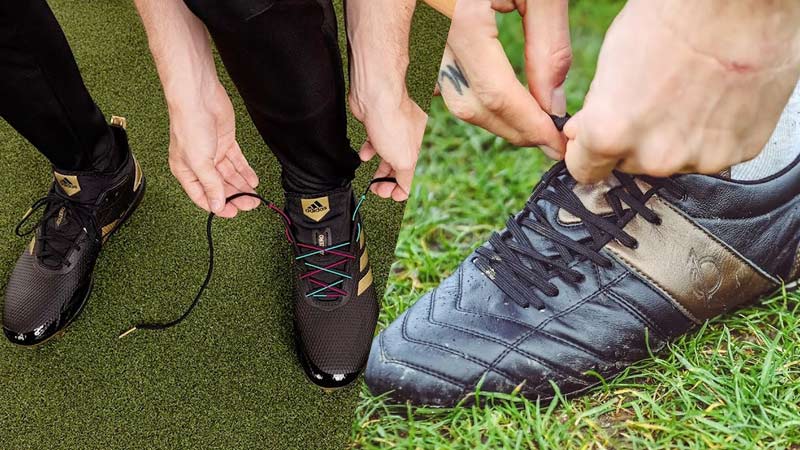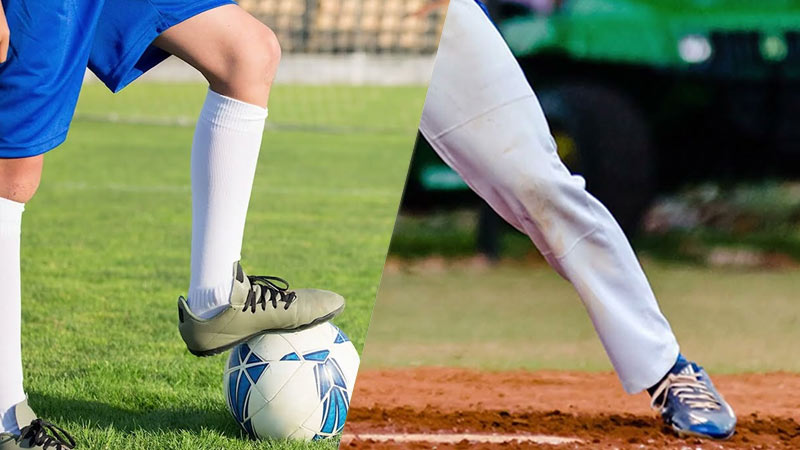When it comes to sports footwear, the right choice of cleats can significantly impact performance and safety. Soccer cleats and baseball cleats are designed specifically for the unique demands of each sport.
While they may appear similar at first glance, there are crucial differences between the two.
In this comprehensive guide, we will delve into the distinctions between soccer cleats and baseball cleats, examining their features, functionality, and suitability for their respective sports.
Whether you’re a soccer player or a baseball enthusiast, understanding these differences will help you make informed decisions when selecting the appropriate footwear. Let’s get started.
What Are Soccer Cleats?
Soccer cleats also referred to as football boots, are specialized footwear designed specifically for the sport of soccer.
These cleats are tailored to enhance a player’s performance on the soccer field by prioritizing agility, ball control, and quick changes of direction. Here’s a closer look at soccer cleats, their design, and their key features.
Low-cut Design
Soccer cleats typically feature a low-cut design, offering freedom of movement for the ankles. This design allows players to have better control over the ball and promotes agility and swift changes in direction.
Lightweight Construction
Soccer cleats are constructed with lightweight materials to minimize the burden on players’ feet. This lightweight construction ensures that players can move swiftly and comfortably throughout the game.
Studs or Blades
The outsole of soccer cleats is equipped with either studs or blades to provide traction on grass or artificial turf surfaces. The configuration and pattern of the studs or blades vary depending on the playing surface and the player’s position, ensuring optimal grip and stability.
What Are Baseball Cleats?
Baseball cleats are footwear specifically designed to meet the demands of the game of baseball.
These cleats prioritize stability, support, and grip to accommodate the unique movements and requirements of baseball players.
Let’s delve deeper into the design and features of baseball cleats.
Mid-cut or High-cut Design
Baseball cleats often feature a mid-cut or high-cut design, providing additional ankle support and stability. This design helps protect the ankles from potential injuries during quick lateral movements and sudden stops.
Sturdier Construction
Compared to soccer cleats, baseball cleats are generally built with a more substantial construction to withstand the rigors of the game. They are designed to endure the lateral movements, sliding, and pivoting involved in baseball.
Metal or Molded Spikes
The outsole of baseball cleats incorporates either metal or molded spikes to provide traction on grass or dirt fields. Metal spikes offer excellent grip but are commonly restricted to professional and select amateur leagues.
Molded spikes, usually made of rubber or hard plastic, provide solid traction and are allowed in most leagues.
Key Differences in Design
Soccer cleats feature a low-cut design, while baseball cleats typically have a mid-cut or high-cut design for enhanced ankle support.
Variation in Construction
Baseball cleats are constructed with sturdier materials to withstand the demands of the game, while soccer cleats prioritize lightweight construction for agility.
Traction Systems
Soccer cleats utilize studs or blades for traction on grass or artificial turf, whereas baseball cleats employ metal or molded spikes for grip on grass or dirt fields.
So, soccer cleats and baseball cleats are tailored to meet the specific demands of their respective sports. Soccer cleats prioritize agility and ball control, while baseball cleats focus on stability and support.
Soccer Cleats vs Baseball Cleats

Let’s discuss the differences between Soccer Cleats and Baseball Cleats in the next phase of this article. Check them out below.
Design and Construction
Soccer cleats typically feature a low-cut design that allows for maximum freedom of movement and agility on the field. This design enables soccer players to make quick cuts, changes in direction, and precise ball control.
On the other hand, baseball cleats often have a mid-cut or high-cut design, providing additional ankle support and stability during running, sliding, and quick lateral movements.
Traction
When it comes to traction, soccer cleats, and baseball cleats differ in their outsole configurations. Soccer cleats have studs or blades that are strategically placed on the outsole to provide optimal grip on grass or turf surfaces.
These studs are designed to penetrate the ground slightly and offer traction while allowing for quick pivots and turns.
Baseball cleats, on the other hand, feature spikes, either made of metal or molded plastic, to provide traction on grass or dirt fields.
The spikes are usually longer and more rigid, providing stability during running, sliding, and sudden stops on the baseball diamond.
Materials
The choice of materials for soccer cleats and baseball cleats is based on the demands of each sport. Soccer cleats are often made with lightweight materials such as synthetic uppers or lightweight leather.
These materials enhance speed and agility while offering flexibility and breathability. Baseball cleats, on the other hand, are constructed with more durable materials like leather or synthetic leather.
These materials are chosen to withstand the rigorous demands of the game, including running, sliding, and potential contact with hard surfaces.
Cleat Configuration
The configuration of cleats on the outsole also differs between soccer cleats and baseball cleats. Soccer cleats typically have a larger number of smaller studs or blades to provide multi-directional traction and quick turns.
This design allows soccer players to move swiftly on the field and make agile maneuvers. In contrast, baseball cleats usually have fewer spikes to prioritize stability and grip during running, sliding, and sudden bursts of acceleration.
The spike configuration on baseball cleats is often focused on providing traction in a linear direction.
Safety Considerations
When considering the safety aspect, it’s important to note that baseball cleats with metal spikes can pose a potential risk in soccer. Soccer is a contact sport, and the higher possibility of contact between players’ legs increases the likelihood of injury from metal spikes.
On the other hand, soccer cleats with longer studs specifically designed for soft ground may not provide adequate traction on the harder surfaces typically found on baseball fields.
Therefore, it is important to use the appropriate cleats for each sport to ensure safety and optimal performance.
Field Compatibility
Soccer cleats are designed for playing on grass or artificial turf surfaces commonly used in soccer. The studs or blades on soccer cleats are suitable for these types of fields, providing traction and preventing slippage.
Baseball cleats, on the other hand, are specifically designed for the grass or dirt fields typically found in baseball.
The spikes on baseball cleats are designed to dig into the ground and provide stability during running, sliding, and quick changes in direction on these surfaces.
Position-Specific Variations
In soccer, cleat designs may vary depending on a player’s position and playing style. For example, forwards may prefer cleats that prioritize speed and agility, while defenders may opt for cleats that provide additional support and stability.
This variation allows players to choose cleats that suit their specific needs and playing style. In contrast, baseball cleats generally have a more standardized design across different positions, as the focus is primarily on traction, stability, and durability.
Can I Wear Soccer Cleats to Play Baseball?
Soccer cleats and baseball cleats are designed for different purposes. Soccer cleats are designed to provide traction on grass or turf surfaces and prioritize agility and maneuverability.
On the other hand, baseball cleats are specifically engineered for the demands of baseball, focusing on stability, support, and traction on dirt or grass fields.
Ankle Support and Stability
One of the key differences between soccer and baseball cleats is the level of ankle support and stability they offer.
Baseball cleats often have a higher cut design, providing more ankle support and reducing the risk of ankle injuries during quick lateral movements or sudden changes in direction.
Soccer cleats, in contrast, typically have a lower cut to allow for a greater range of motion and flexibility.
Safety Concerns
The spikes on baseball cleats, especially metal spikes, are longer and more prominent than those on soccer cleats.
While they provide necessary traction on dirt or grass fields, these spikes can pose a safety hazard in soccer, increasing the risk of injuries during player collisions or accidental contact with opponents.
Soccer cleats, with their shorter and less aggressive studs, are designed to prioritize player safety during soccer-specific movements.
Performance and Comfort
Wearing the appropriate cleats for each sport is crucial for optimal performance. Baseball cleats are specifically designed to enhance traction, stability, and power during baseball-specific movements such as running, cutting, and sliding.
Using soccer cleats for baseball may result in less traction, compromised stability, and potentially hinder performance.
Investing in the right equipment, including sport-specific cleats, ensures that players can perform at their best and reduce the risk of performance-related issues.
While it may be tempting to use soccer cleats for baseball or vice versa, it is generally not recommended. The design differences, particularly in ankle support, stability, and safety features, make soccer cleats unsuitable for baseball.
FAQs
Can I wear soccer cleats on a baseball field?
It is not advisable to wear soccer cleats on a baseball field as they lack the necessary traction and stability provided by baseball cleats. They may also pose a safety risk due to the differences in spike design.
Can I use baseball cleats for soccer?
Baseball cleats are not recommended for soccer due to their different design and spike configuration. Soccer cleats offer better performance and safety features specifically tailored for the sport.
Can I wear soccer cleats on artificial turf?
Yes, soccer cleats are designed for use on both natural grass and artificial turf surfaces. The stud or blade configuration on soccer cleats provides suitable traction for these playing conditions.
Are metal spikes better than molded spikes in baseball?
The choice between metal spikes and molded spikes in baseball depends on personal preference and league regulations. Metal spikes offer superior traction, but molded spikes are often required in youth leagues and some recreational settings for safety reasons.
Can I wear soccer cleats for other sports?
Soccer cleats are primarily designed for soccer but can also be suitable for other sports played on grass or turf surfaces, such as lacrosse or field hockey.
Bottom Line
Soccer cleats and baseball cleats are purpose-built footwear designed to optimize performance and safety in their respective sports.
While they may share some similarities, such as the use of studs or spikes for traction, their distinct features and designs cater to the unique demands of soccer and baseball.
It is essential to choose the appropriate cleats for each sport to maximize performance, reduce the risk of injuries, and comply with league regulations.
So, whether you’re preparing for the soccer field or the baseball diamond, make sure to equip yourself with the right pair of cleats to elevate your game. Best of luck.







